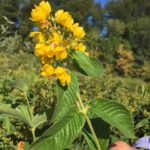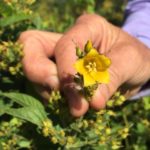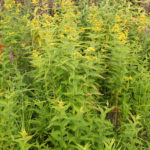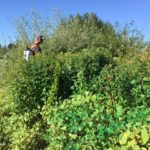Gallery:
- Mature Garden loosestrife infestation
- Garden loosestrife inflorescence
- Garden loosestrife flower
- Distinctive orange-margined sepals of the Garden loosestrife
- Garden loosestrife infestation
- Garden loosestrife being controlled by staff from the Oregon Dept. of Agriculture
Common names:
Garden loosestrife, garden yellow loosestrife,
Scientific Name:
Lysimachia vulgaris
Description:
Garden loosestrife is a tall upright rhizomatous noxious weed that grows up to 5 feet in height. It is characterized by terminal panicles of bright yellow 5-petaled flowers. Leaves are opposite to whorled, nearly sessile and lanceolate 7-12 cm in length. The stems and leaves are soft and hairy. Flowered are ringed by distinctive orange-margined green sepals. Underground rhizomes can spread to lengths up to 15 feet. Plants reproduce from both rhizomes and seeds.
Life cycle:
Height of mature plants
3 to 6 feet
Flower color:
Yellow 5- petaled flower, that lack reddish or black streaks or dots
Bloom time:
Typically blooms during July and August.
Look-a-likes:
The closely related Yellow loosestrife (Lysimachia punctata) is a less aggressive garden ornamental, with lower flowers from emerging from the leaf axils, and the yellow flowers lack the orange-margined sepals, characteristic of the noxious garden loosestrife.
Habitat:
Garden loosestrife is found escaping in wetlands and along streams and river. It is also likely to be found in garden setting. This species is known to occur in only one location in Oregon.
Impacts:
Garden loosestrife invades wetland and riparian areas, where it displaces desirable native vegetation. Once established it can spread rapidly, and has been known to displace very hearty plants such as cattails. Invasion by garden loosestrife disrupts habitat for fish and wildlife, and can limit recreation opportunities in highly invaded sites.
Noxious Weed Listing:
- WeedWise: Priority
- State of Oregon: Class A,T
- State of Washington: Class B
- Four County CWMA: A
- Columbia Gorge CWMA: A
Origin:
This species is native to Europe.
Present in Clackamas County:
No
Links:
King County Noxious Weed Program
Invasive Plant Atlas of New England






